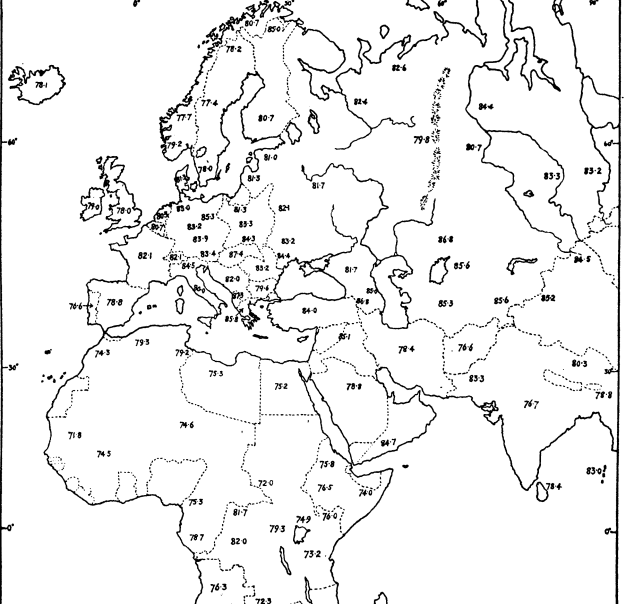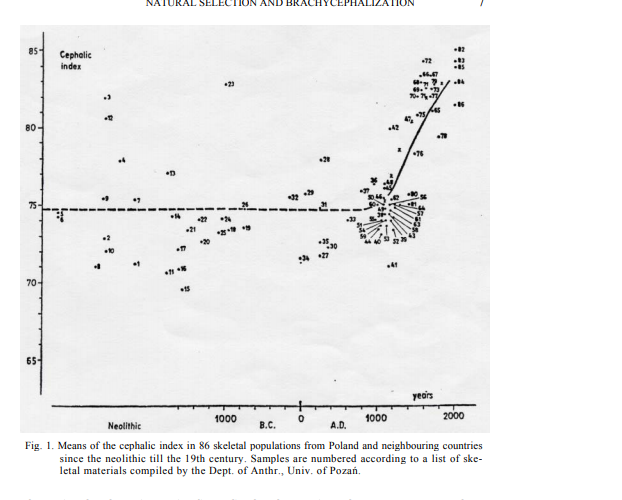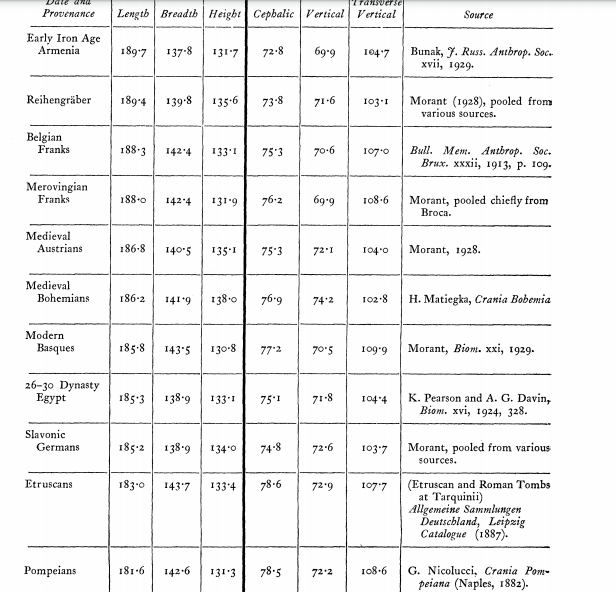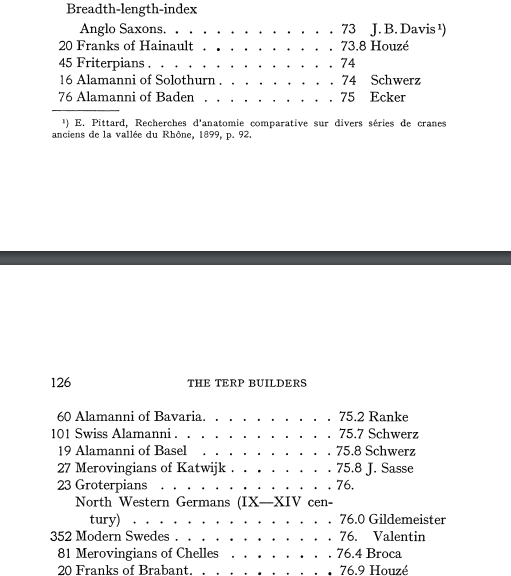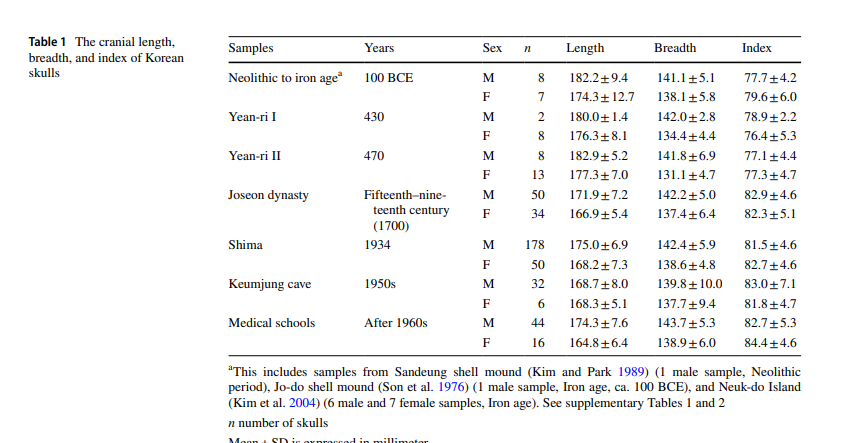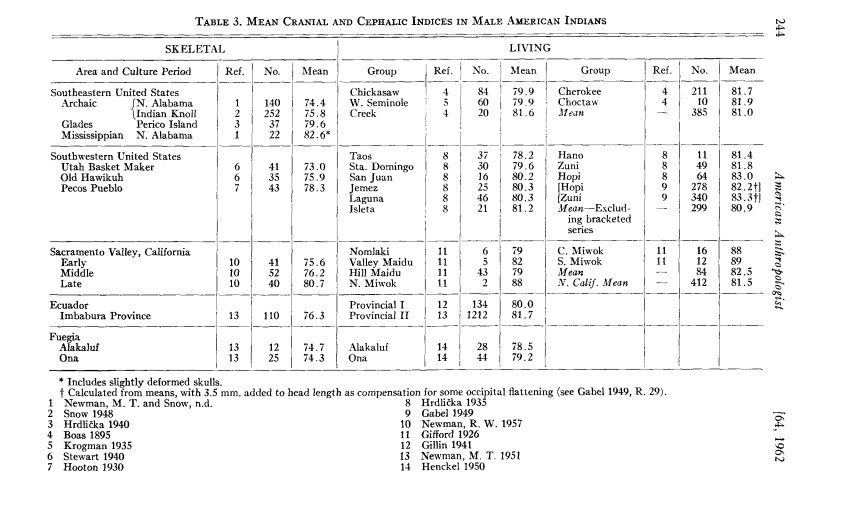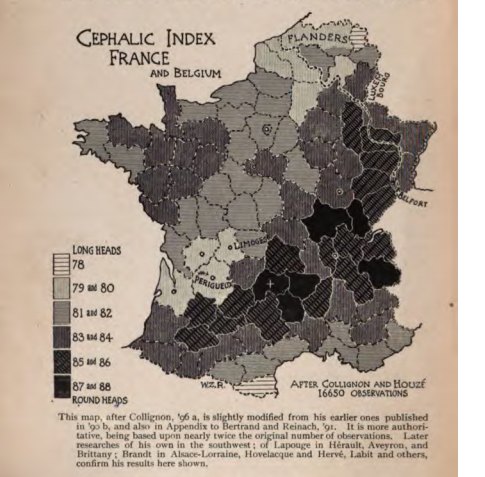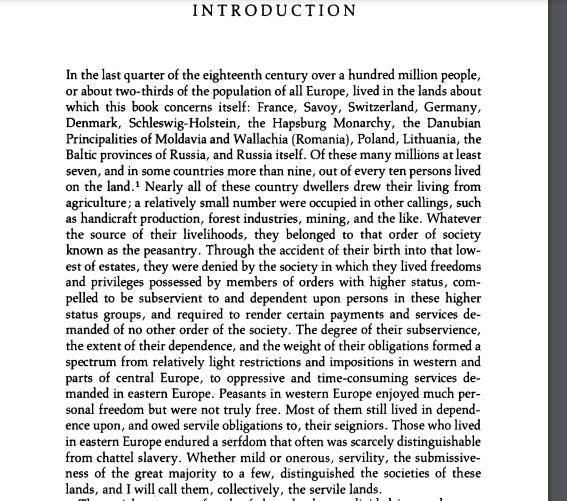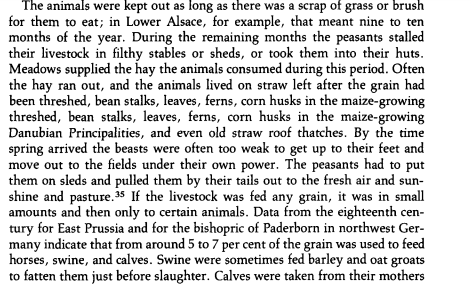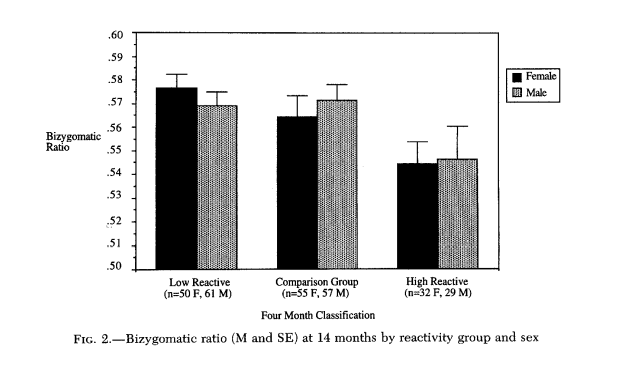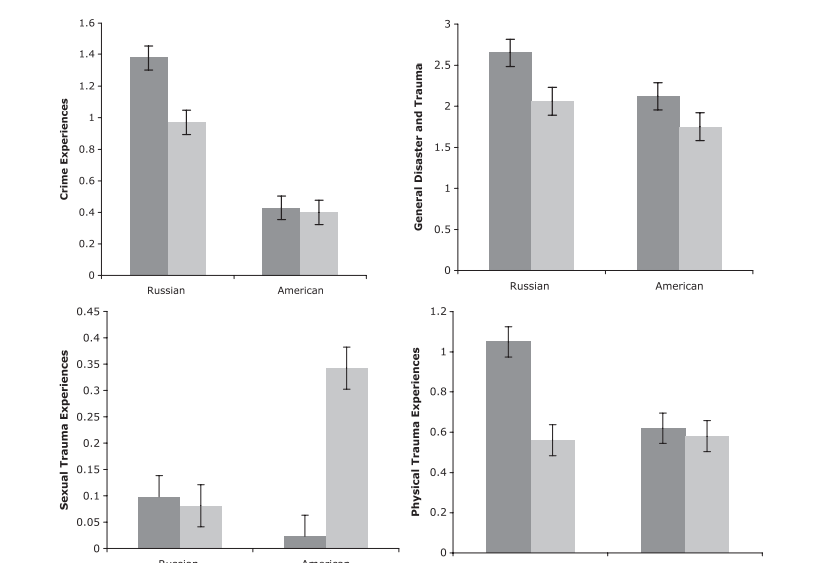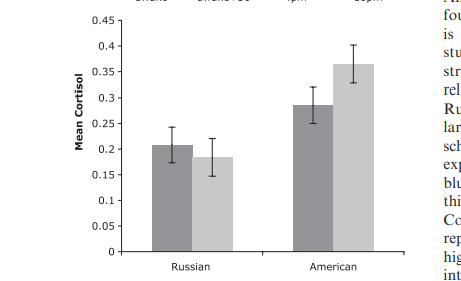Going to argue today that societies in which agriculture is performed collectively in and around nucleated villages act to domesticate human beings via the same biological pathway as in dogs and cats and is apparent in a similar shortening and broadening of their skulls
The second central point is that behavioral domestication is a result of an increased tolerance for stress and that people who were most thoroughly feudalized (most Slavs, Germans, French) have adapted by becoming harder, less fearful of people, and overall less eccentric.
The cephalic index measures the length of the skull divided by its width. Values of about 75 or less are considered dolicocephalic or long headed (like Ridley Scott’s Alien). More than 81 is brachycephalic or broad headed like a bulldog. Populations vary from means of 70-90.
The lowest index values are found in tropical populations like Africans or Australian aboriginals and their long, narrow heads seem to be an adaptation to dissipate heat related to their long limbs and fingers. The highest value seen in Siberians seem to have an opposite cause.
Europeans vary extensively in CI, more than you would think given their low Fst. Climate plays very little role in explaining these differences. Values range from around 76 in Iberians and True Scandinavians to values 85 or above in the Balkans with an sd of about 4.5.
In 1100 Poles had cranial indexes lower than any population in Europe today, but the advent of feudalism produced a lightning change in the shape of their skulls that in was closer in magnitude to two standard deviations than one:
In other words, Poles didn’t used to look like Poles. But then again practically everyone has changed: today’s bulldog headed Germans, French, Bohemians, and Armenians had medieval ancestors with CIs lower than any in Europe today. Only the Basques have held constant:
What happened to Slavs is striking because it happened so fast, but this same process has affected everyone, even people who are today relatively dolicocephalic. The English have CIs today of around 77-78 but used to be <75, the Dutch are about 80 but used to be about 75:
Another place where broad headed peoples arose with extreme speed was Georgia. After the advent of feudalism, averages moved from 76-83, more so in highland areas than others. This also happened at the same time in Armenians and other Caucasians: https://sci-hub.se/https://www.journals.uchicago.edu/doi/abs/10.1086/203172?journalCode=ca
Brachycephaly is something people associate with East Asians, but their current skull shape also arose quite late. The major shift in Korean head form took place at some unknown date between 470 A.D. and the 15th century:
And to top it all off, even American Indians have become more brachycephalic in the last 5,000 years, although the changes have not been as dramatic as in some other places:
There are two important clues that can help explain what has been driving this effect. The first, as is seen in Eastern Europe and the Caucasus, is that skulls began to shorten as feudalism was introduced. The second is that mountain peoples are almost always brachycephalic.
The best review of old racial anthropology data is Carleton Coon’s The Races of Europe which you can read here https://www.theapricity.com/snpa/racesofeurope.htm . Coon was almost oblivious to the concept of natural selection, but his data make it clear that mountain living drives brachycephalization.
In the Middle East the most broad faced peoples live in the Caucasus and Turkey. Predictably, the only brachycephalic Arabs are the Lebanese, the only brachycephalic Iranians the Bakhtiari. Assyrians are ultra-brachycephalic, but according to Coon this happened very quickly:
"These Assyrians, whose ancestors, presumably plainsmen from Iraq, may have been no different in a physical sense from the other inhabitants of that valley, are now, after some six hundred years of living in the mountains, more brachycephalic than the Armenians." (87)
One of the countries with the sharpest internal divides in CI is Romania, where people on the plains have mesocephalic values similar to Bulgarians (80) whereas those in mountainous regions like Bukovina are ultra-brachycephalic (85-86).
In France the most wide faced people live in and around the mountainous Auvergne. Similarly, the brachycephaly of North Italians and South Germans give the “Alpine” race its name. This is from Ripley’s original Races of Europe:
While mountain peoples are usually brachycephalic, there are exceptions to the rule that help to shed light on the way the process works everywhere: mountain people who practice traditional pastoralism like Kurds and Afghans have retained their ancient skull form.
"All groups of Kurds, however, have not fully escaped this brachycephalization. The Bilikani Kurds, who live among Armenians near Erivan, have a mean cephalic index of 84; others, who live in northeastern Iraq and who are fully sedentary, have (also) been altered".
This makes it clear that it is not mountain living per se, but the sedentism associated with agriculture that is the driving agent here. There is something basically similar in the style of life between these mountainous farmers and those in feudalized regions of North Europe
The common factor is the social environment of village life, which faintly resembles the conditions animals face in a zoo. The best way to understand the distinctive character of Alpine peoples like Slavs is to see them as people of the village.
The distinctive European village with its communally owned and regulated lands was once thought to be almost as old as agriculture itself, but 20th century historians have clarified that it began quite recently. This from Jerome Blum: https://www.jstor.org/stable/3741976?seq=1
The first proper W. European villages arose in the 8th century. There is a bit of a chicken/egg debate with regards to feudalism and villages, but villages definitely came first and may have made feudalism possible by making it easier to control peasants https://www.utpjournals.press/doi/abs/10.3138/cjh.48.2.22
In both Europe and the Caucasus feudalism was accompanied by the introduction of new heavy plows, the carruca and Caucasian gutani which allowed for the exploitation of heavier soils. The gutani was pulled by a team of 16 oxen, which necessitated communal ownership of livestock.
It didn’t work this way exactly everywhere but the general trend was heavy plows pulled by many oxen> communal ownership of animals and land>villages> feudal exploitation.
Feudalism is a broad term, and feudalism was more transient in some countries (England) than others, whereas some got off scot-free (Norway). My definition of a "feudal country" is one where the labor demands of lords were imposed for the better part of a millennium.
Jerome Blum defined “the servile lands” as: France, Savoy, Switzerland, Germany, Denmark, Schleswig-Holstein, the Hapsburg Monarchy, the Danubian Principalities of Moldavia and Wallachia (Romania), Poland, Lithuania, the Baltic provinces of Russia, and Russia itself"
The labor demands lords imposed on their peasants were so heavy that it’s amazing there were not constant rebellions. In Denmark and Schleswig a man owed 200 days of labor to their lord, sometimes forcing them to plough their own lands under moonlight:
In places in which women perform real physical labor they often quit breastfeeding early and sometimes avoid the practice altogether, as was the case until recently in Catholic Germany and Russia. The effects on infant mortality were horrendous. https://twitter.com/crimkadid/status/1334934056874676224
From 1300-1700 while Europeans ventured forth to conquer the world agricultural productivity remained stagnant in the servile lands, even as population increased. Lands were shifted away from pasture to grow grain, which tended to deprive the peasants of milk and meat:
There’s a correlation of about -0.5 between % lactose tolerant and the CI: e.g. French are the most wide faced and LI people in Western Europe. Feudalism seemed to interrupt selection in this area; the only people who ended up lactose tolerant and brachycephalic are the Germans.
By any standard the lives of these peasants were harsh, but there’s something that made it worse. Many tasks were performed by the community and there were long days peasants spent surrounded by others, not just friends or family, but everyone: people they didn’t like, assholes.
Other than maybe Jews or Parsis no one is truly adapted to city life, because high mortality from diseases made old cities population sinks. The active community life and cooperative agriculture in rural villages though produced much the same effect.
Feudal communities were practically states within themselves. Because lands and animals were communally owned, they were jealously guarded and interlopers were automatically assumed to be thieves. A peasant spent his whole life in a glorified pen.
Agricultural life in mountains resembled feudalism in that it required constant cooperative activity and geography naturally restricted movement in much the same sense feudal lords did: you only have so far to wander when boxed in mountains.
Peasant life was a thresher. The people who couldn’t cut it were partly those who couldn’t meet the physical demands without succumbing to exhaustion and infection, but also those who felt penned in, who dreamed of what life would be like on the other side of the mountain.
Okay, so life was stressful, but what does that have to do with skull shape? Why do different species of domesticated animals invariably end up with short, broad skulls?
Two researchers at Harvard made note that in animal studies high levels of glucocorticoids inhibit the outward development of the upper jaw. They decided to measure if the same relationship between skull form and stress reactivity occurred in humans: https://sci-hub.se/https://srcd.onlinelibrary.wiley.com/doi/abs/10.1111/j.1467-8624.1995.tb00950.x
462 subjects at ages 4 and 14 months were examined and ranked by judges by their "reactivity", their tendency for example to cry when separated from their mothers. The broad faced children were considerably less reactive:
I suspect that the outward development of the jaw is paralleled by outward development of the shoulders because brachycephalized people are usually quite broad, and outside of cold mountains, long limbed in the sense of the stereotypical “European supermodel”.
Just incidentally: one of the authors of that paper, Jerome Kagan, also performed similar work which demonstrated that blue eyed children were considerably more fearful and inhibited at early ages than brown eyed ones: https://onlinelibrary.wiley.com/doi/abs/10.1002/dev.420220802
So to the point: is there any direct evidence that brachycephalic peoples are more resistant to stress than say, typical white Americans? Before cortisol was measured these researchers asked American/Russian college students about life stresses: https://sci-hub.se/https://www.tandfonline.com/doi/abs/10.1080/00207590903452309
The Russians had overall had more stressful lives than the Americans (except for the fact that apparently every US college girl has been sexually assaulted). The researchers therefore expected Russians to have higher circulating levels of cortisol but found exactly the opposite:
A very similar study comparing Swedes to Greeks also found that while the Greeks had undeniably harder lives they also had lower cortisol levels, again contrary to researcher expectations: https://journals.plos.org/plosone/article?id=10.1371/journal.pone.0073828
If someone had the gall to autopsy people from different European populations with this in mind I think what they would find is that brachycephalic peoples would have smaller adrenal glands in the kidneys, which is the most consistent byproduct of animal domestication
Alpine peoples are resistant to the stressful effects of hard labor partly because they are dull: they do not need constant novelty and stimulation to be happy. They are perfectly content to live in the same place forever, feel no pressure to throw it all away and emigrate.
Slavs are so normal. So many guys I’ve met are described by their friends as: “He is just a nice, regular guy. Normal and unpretentious”. I have to resist the urge to call them “boring”, which they aren’t, but they do talk about a restricted range of practical subjects.
There’s a real monotony to them: every Slav with a blog I read writes exclusively about his own country and often very practical, mundane aspects of it. Every Frenchman takes odd excuses to start talking about France. The Caucasians though, are the absolute worst
The most brachycephalic peoples in Europe (Balkans) and the Middle East (Caucasians) are so ethnocentric and willing to throw down on a moment’s notice that it would probably be beneficial for the UN to forcefully separate them to avoid any more predictable violence.
But you see this in all the broad faced countries, or you used to anyways. The constant revanchism, the racially tinged ultra-nationalism which distinguishes the Germans or Koreans from their neighbors.
These peoples fight so often partly because they are brave, but also because they are not deterred by the hard, boring work of real soldiers, which can be so draining it makes deadly combat seem like a relief. If you could handle feudalism, you can handle war.
The idea that human beings have been self-domesticated is very old, but the execution of the idea is always wrong. Biologists have traditionally imagined domesticated people as being easy going hippies, whereas the truth is that civilization makes you hard, not soft.
It's wolves who are shy and fearful, not bulldogs. Domesticated animals don't piss themselves in fear constantly and lose weight when trapped in captivity. They can take it. A domesticated human isn't Jeff Lebowski, he's Fedor Emelianenko
Biologists are right though, I think, in describing wild humans as “xenophobic”, in the sense that American whites live in constant fear of blacks to the point of reflexively praising them for doing nothing. The Russian attitude toward foreigners is more "civilized", fearless.
Alpine peoples are obviously very different from other (French, North Italian, German, Slavic) but to me the one striking mannerism they all share is a tendency, during argument, to invade the personal space of the other guy and go nose to nose like Tony Soprano.
Everyone has an invisible bubble around them which strangers aren’t supposed to enter without permission. The size of the bubble, dictated by stress, informs a person's intuitions about “rights” and “privacy”, in Norwegians the bubble is huge, in Alpines it’s tiny.
The lack of fear Alpines show makes them willing to boldly approach others, especially in Mediterranean countries, and this sometimes manifests itself as a kind of Pepe LePew rapiness. They're vulgar, laugh loudly at dirty jokes, and speak bluntly about everything.
Some peoples have genuinely unique personalities, like the Jews and Irish, but most national characters were not selected for per se but emerge from unusual combinations of traits. To give one relevant example, the Germans:
Northwest Europeans have a distinctive mental style, an nerdy memory for facts and little details and a way of seeing the world autistically, abstractly, to store facts about human beings in the same mental compartments as fictional characters or animals.
The Germans are uniquely dangerous people because they combine this kind of nerdy facility for organization and planning with a hardness and racial arrogance more typical of Slavs. They are very much like other Alpines with one important exception: they are competent.
The kinds of cruelty, on a national or individual level, that Germans are capable of is related to this sort of crossroads personality. NW Euros are autistic and inhuman, but this is mitigated by their softness. Slavs are hard, but also warm. Germans are neither warm nor soft.
Russians too have a character that is the result of an unusual combination: an Alpine ease around people mixed with a stoic, unemotional harshness shared with other northern peoples like Scandinavians.
Practically anything I have written about the broad faced people of Europe and the Middle East is true, maybe doubly true, of East Asians who also traditionally practiced collectivized agriculture. You can think of Alpines as “domesticated”, but also as “Orientalized”.
So what then it is like to be wild, at least by European standards? The best illustration would be the pathological shyness of Norwegians, who have a way of filling up a bus one by one while always maintaining the maximum possible distance between passengers.
But the people of British Isles are also quite long headed and not quite the same and Iberians are downright extraverted . The common element between them is a softness toward children and animals, an easy going laziness: a philosophy of “that’s just like, your opinion, man”
They wander and emigrate more than Alpines, easily feel cramped and stifled by monotony. They indulge themselves in flights of fantasy; they wander mentally as well as physically. They speak theatrically, “idealistically” They do not take orders well.
Life would be easy if we were all immune to stress, which raises the question of what cortisol exactly does for us. The most obvious answer is that it makes breathing easier, infants with weak lungs can be saved by administering glucocorticoids: https://onlinelibrary.wiley.com/doi/abs/10.1002/ppul.1092
Dogs are not uniformly brachycephalic, they vary in proportion to their physical demands: the more a dog wanders and runs the more its facial proportions resemble that of dolichocephalic horses. Brachycephalic bulldogs have real difficulty breathing: https://en.wikipedia.org/wiki/Brachycephalic_airway_obstructive_syndrome
There are three clusters of people in Europe that produce large numbers of great distance runners: 1. Norway 2. Iberia and 3. Britain, especially Wales. The universal pattern, in Europe or in Africa, is that people who raise animals in hills, like the Kalenjin, can run for days.
There is essentially a trade off: active human societies of hunters, herders, or isolated farmers maintain strong lungs, primarily I think to survive respiratory infections. When life becomes sedentary and stressful cortisol no longer pays for itself.
That’s the end of my 4,000 tweet thread. Hope it brought all the peoples of the world together, even the ones I don’t like.

 Read on Twitter
Read on Twitter